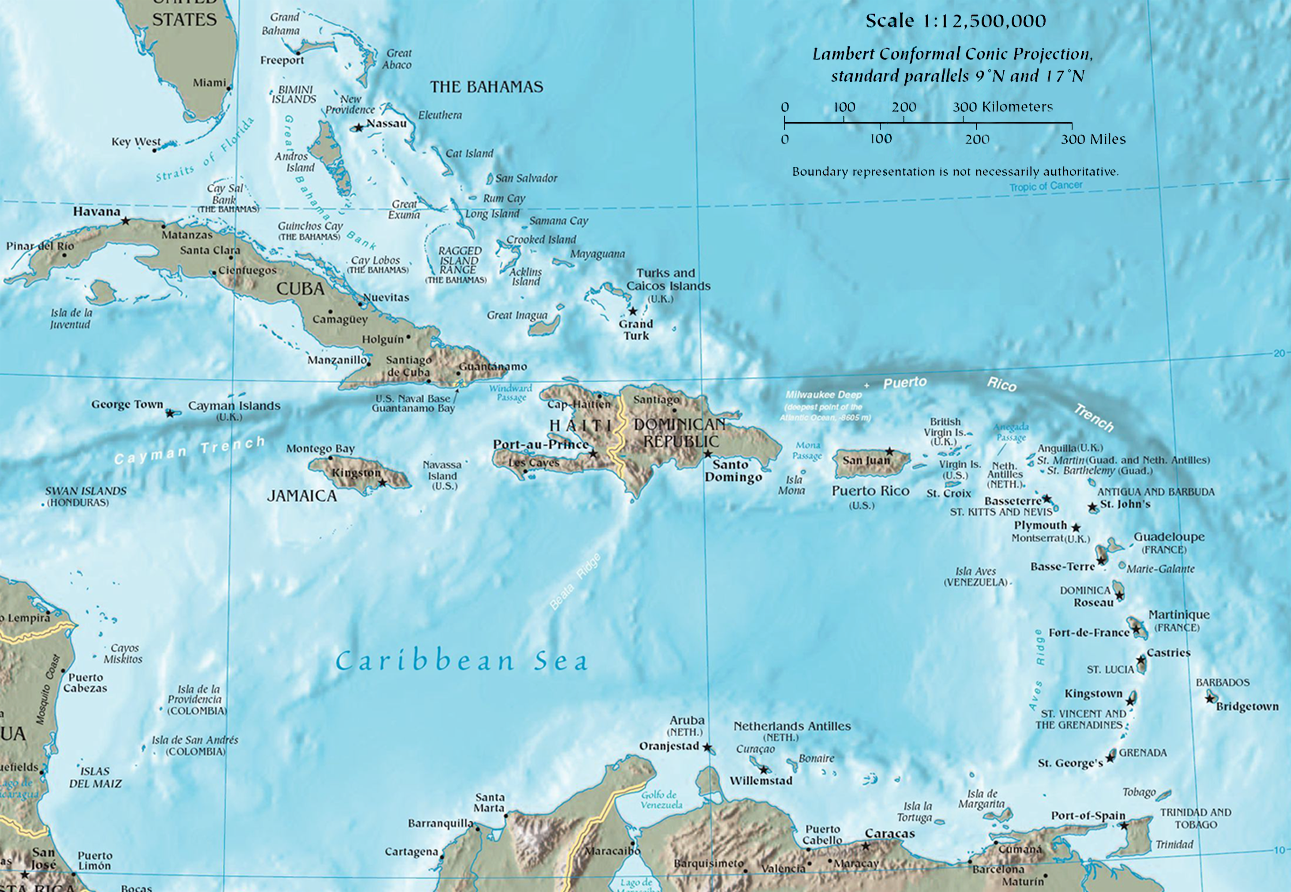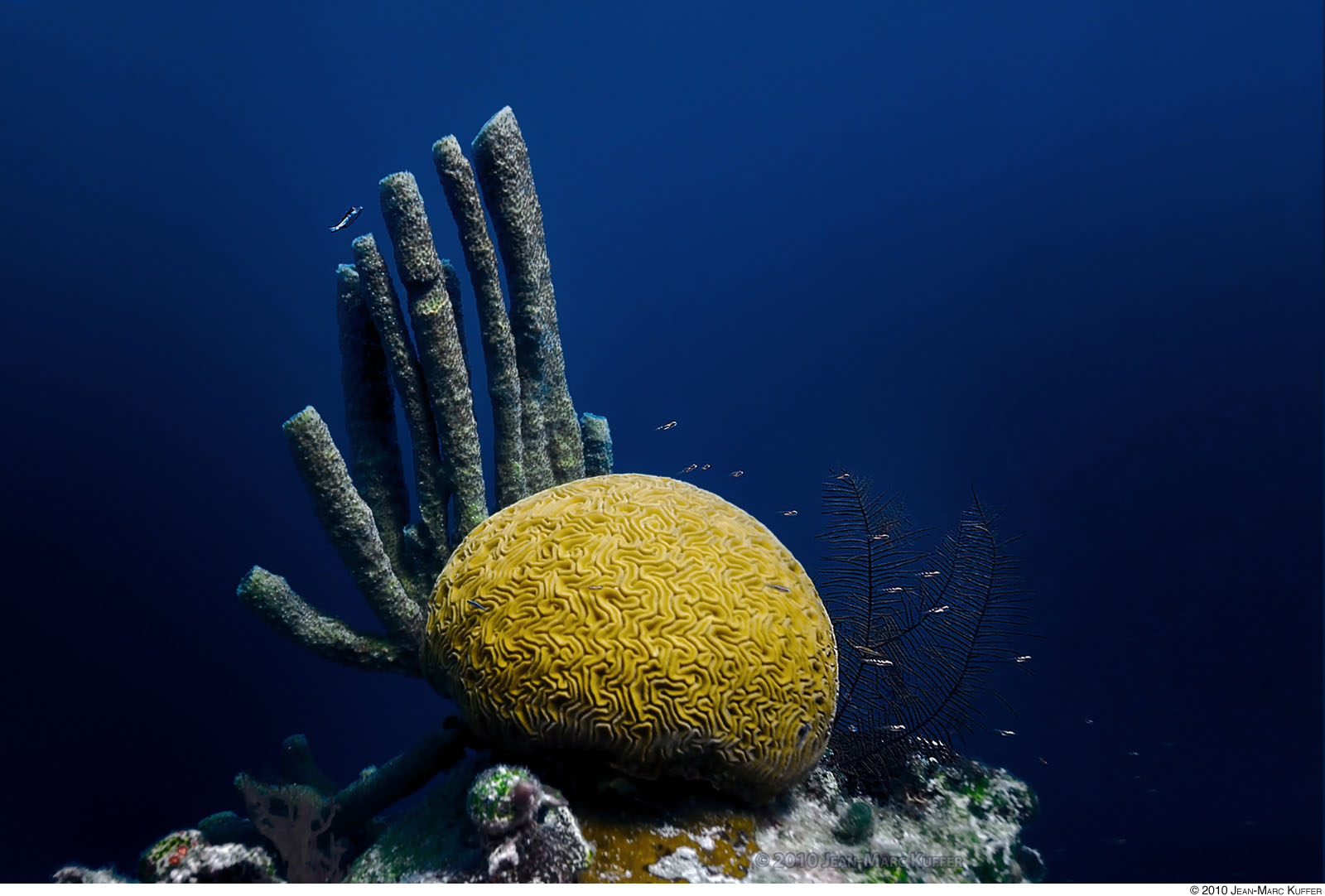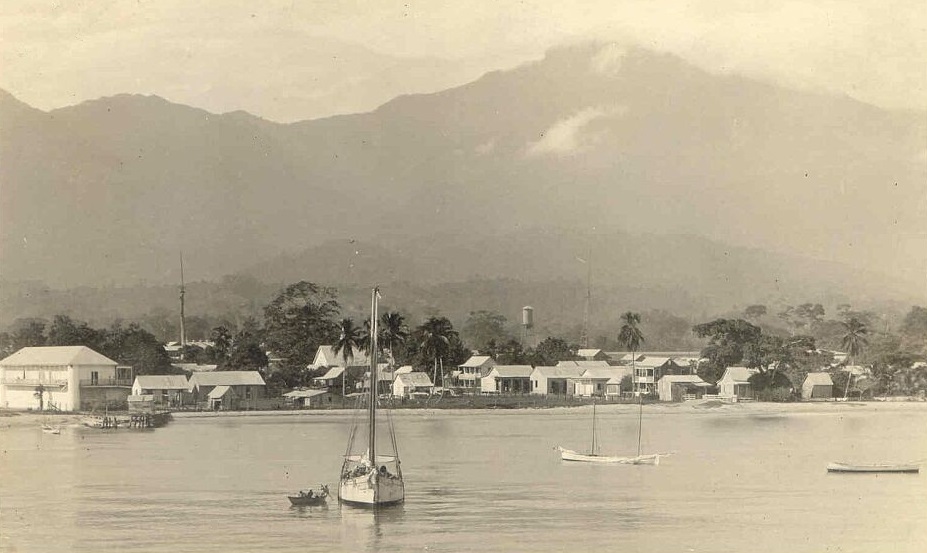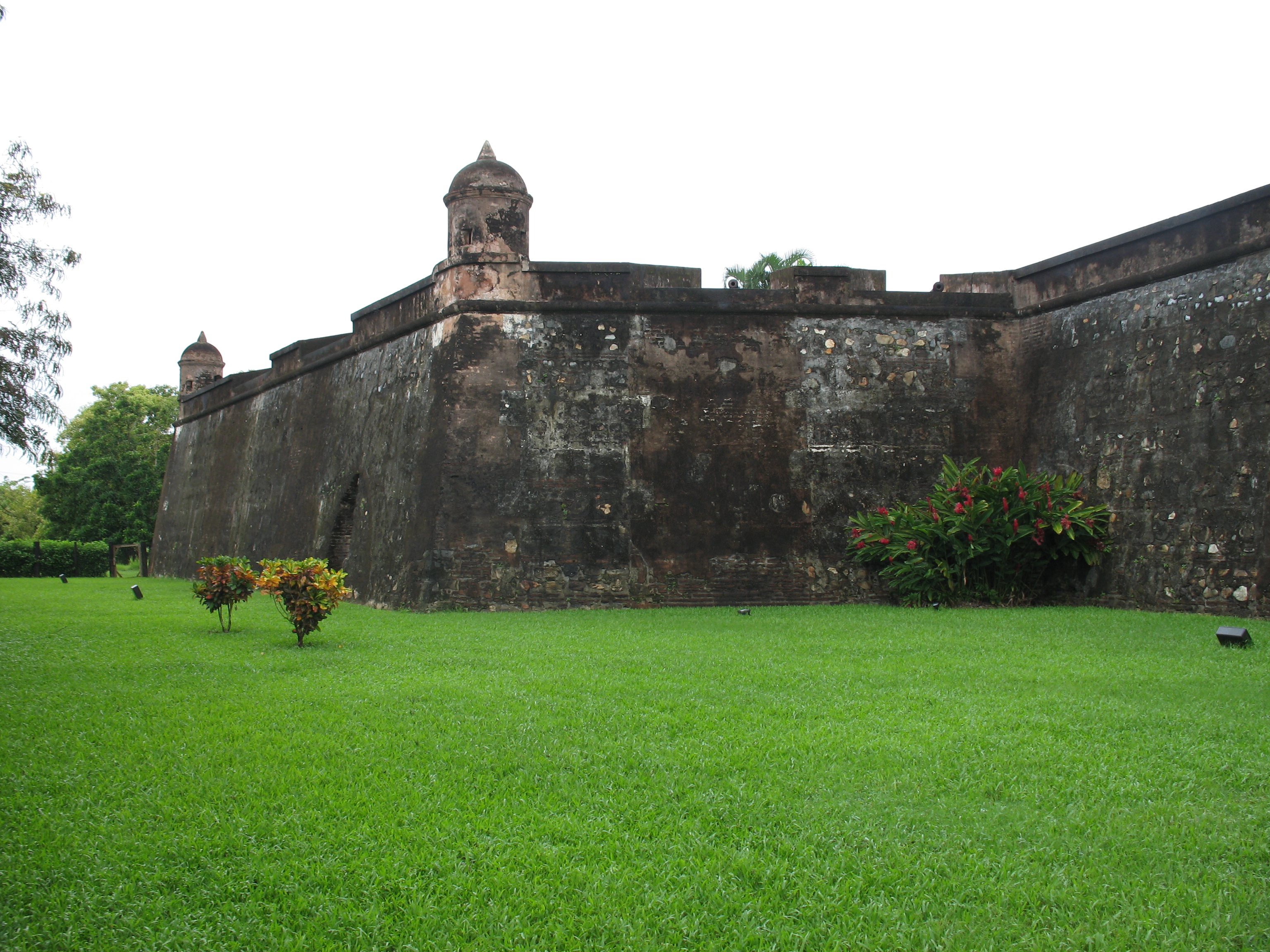|
Gulf Of Honduras
The Gulf or Bay of Honduras is a large inlet of the Caribbean Sea, indenting the coasts of Belize, Guatemala, and Honduras. From north to south, it runs for approximately 200 km (125 miles) from Dangriga, Belize, to La Ceiba, Honduras. The inner Gulf of Honduras is lined by the Belize Barrier Reef which forms the southern part of the 900 km (600 mile) long Mesoamerican Barrier Reef System, the second-largest coral reef system in the world. The Belize Barrier Reef includes a number of small islands, called cays, and collectively known as the Pelican Cays. The Gulf of Honduras is marked by complex dynamics of coastal and open waters, and ocean currents, which have produced a very diverse and unique ecosystem with a wide variety of coastal marine waters, including coastline estuaries, barrier beaches, lagoons, intertidal salt marshes, mangrove forests, seagrass beds, keys and barrier reefs. The gulf receives the runoff from the watersheds of 12 rivers with an est ... [...More Info...] [...Related Items...] OR: [Wikipedia] [Google] [Baidu] |
Caribbean
The Caribbean (, ) ( es, El Caribe; french: la Caraïbe; ht, Karayib; nl, De Caraïben) is a region of the Americas that consists of the Caribbean Sea, its islands (some surrounded by the Caribbean Sea and some bordering both the Caribbean Sea and the North Atlantic Ocean) and the surrounding coasts. The region is southeast of the Gulf of Mexico and the North American mainland, east of Central America, and north of South America. Situated largely on the Caribbean Plate, the region has more than 700 islands, islets, reefs and cays (see the list of Caribbean islands). Island arcs delineate the eastern and northern edges of the Caribbean Sea: The Greater Antilles and the Lucayan Archipelago on the north and the Lesser Antilles and the on the south and east (which includes the Leeward Antilles). They form the West Indies with the nearby Lucayan Archipelago (the Bahamas and Turks and Caicos Islands), which are considered to be part of the Caribbean despite not bordering the Caribbe ... [...More Info...] [...Related Items...] OR: [Wikipedia] [Google] [Baidu] |
Hopkins, Belize
Hopkins Village is a coastal village in eastern Belize. Culture Hopkins is a Garifuna village on the coast of the Stann Creek District in Belize. Hopkins is considered by some Belizeans to be the cultural center of the Garifuna population in Belize. The town hosts its own national holiday, Hopkins Day, and welcomes people for their celebration on Garifuna Independence Day as well, they do this with drum ceremonies that can last till early hours in the morning. Geography The village is separated into two parts; the Northside (Baila) and the Southside (False Sittee). Hopkins is surrounded by the Maya Mountains and the Cockscomb Range inland, and the Caribbean Sea on its shore. It is also very close to the Sittee River Sittee River is a river in Belize. It is also the name of a village along the river. River Located in central Belize, the mangroves located at the mouth of this river are the tallest ever reported for the Caribbean region and among the tallest an .... The vi ... [...More Info...] [...Related Items...] OR: [Wikipedia] [Google] [Baidu] |
Pelican Cays
The Gulf or Bay of Honduras is a large inlet of the Caribbean Sea, indenting the coasts of Belize, Guatemala, and Honduras. From north to south, it runs for approximately 200 km (125 miles) from Dangriga, Belize, to La Ceiba, Honduras. The inner Gulf of Honduras is lined by the Belize Barrier Reef which forms the southern part of the 900 km (600 mile) long Mesoamerican Barrier Reef System, the second-largest coral reef system in the world. The Belize Barrier Reef includes a number of small islands, called cays, and collectively known as the Pelican Cays. The Gulf of Honduras is marked by complex dynamics of coastal and open waters, and ocean currents, which have produced a very diverse and unique ecosystem with a wide variety of coastal marine waters, including coastline estuaries, barrier beaches, lagoons, intertidal salt marshes, mangrove forests, seagrass beds, keys and barrier reefs. The gulf receives the runoff from the watersheds of 12 rivers with an est ... [...More Info...] [...Related Items...] OR: [Wikipedia] [Google] [Baidu] |
Mesoamerican Barrier Reef System
The Mesoamerican Barrier Reef System (MBRS), also popularly known as the Great Mayan Reef or Great Maya Reef, is a marine region that stretches over along the coasts of four countries – Mexico, Belize, Guatemala, and Honduras – from Isla Contoy at the northern tip of the Yucatán Peninsula south to Belize, Guatemala and the Bay Islands of Honduras. The reef system includes various protected areas and parks including the Belize Barrier Reef, Arrecifes de Cozumel National Park, Hol Chan Marine Reserve (Belize), Sian Ka'an biosphere reserve, and the Cayos Cochinos Marine Park. Belize's coastline, including the Belize Barrier Reef, is home to approximately 30% of the Mesoamerican Barrier Reef System. It begins near Isla Contoy on the northern tip of the Yucatán Peninsula and continues south alongside the Riviera Maya including areas like Cozumel and Banco Chinchorro. It then continues south along the eastern coast of Belize including many cayes and atolls. It extends to the ... [...More Info...] [...Related Items...] OR: [Wikipedia] [Google] [Baidu] |
Belize Barrier Reef
The Belize Barrier Reef is a series of coral reefs straddling the coast of Belize, roughly offshore in the north and in the south within the country limits. The Belize Barrier Reef is a long section of the Mesoamerican Barrier Reef System, which is continuous from Cancún on the north-eastern tip of the Yucatán Peninsula through the Riviera Maya and down to Honduras, making it the second largest coral reef system in the world after the Great Barrier Reef in Australia. It is Belize's top tourist destination, popular for scuba diving and snorkeling and attracting almost half of its 260,000 visitors. It is also vital to the country's fishing industry.Harrabin, Roger. (2006-06-12Reef at forefront of CO2 battle BBC News. Retrieved on 2011-10-21. Charles Darwin described it as "the most remarkable reef in the West Indies" in 1842. In addition to its barrier reef, it also boasts three distinct Caribbean atolls: Turneffe Atoll, Glover's Reef and Lighthouse Reef. Lighthouse Reef i ... [...More Info...] [...Related Items...] OR: [Wikipedia] [Google] [Baidu] |
Bay Of Honduras
The Gulf or Bay of Honduras is a large inlet of the Caribbean Sea, indenting the coasts of Belize, Guatemala, and Honduras. From north to south, it runs for approximately 200 km (125 miles) from Dangriga, Belize, to La Ceiba, Honduras. The inner Gulf of Honduras is lined by the Belize Barrier Reef which forms the southern part of the 900 km (600 mile) long Mesoamerican Barrier Reef System, the second-largest coral reef system in the world. The Belize Barrier Reef includes a number of small islands, called cays, and collectively known as the Pelican Cays. The Gulf of Honduras is marked by complex dynamics of coastal and open waters, and ocean currents, which have produced a very diverse and unique ecosystem with a wide variety of coastal marine waters, including coastline estuaries, barrier beaches, lagoons, intertidal salt marshes, mangrove forests, seagrass beds, keys and barrier reefs. The gulf receives the runoff from the watersheds of 12 rivers with an estimate ... [...More Info...] [...Related Items...] OR: [Wikipedia] [Google] [Baidu] |
Gulf Of Honduras
The Gulf or Bay of Honduras is a large inlet of the Caribbean Sea, indenting the coasts of Belize, Guatemala, and Honduras. From north to south, it runs for approximately 200 km (125 miles) from Dangriga, Belize, to La Ceiba, Honduras. The inner Gulf of Honduras is lined by the Belize Barrier Reef which forms the southern part of the 900 km (600 mile) long Mesoamerican Barrier Reef System, the second-largest coral reef system in the world. The Belize Barrier Reef includes a number of small islands, called cays, and collectively known as the Pelican Cays. The Gulf of Honduras is marked by complex dynamics of coastal and open waters, and ocean currents, which have produced a very diverse and unique ecosystem with a wide variety of coastal marine waters, including coastline estuaries, barrier beaches, lagoons, intertidal salt marshes, mangrove forests, seagrass beds, keys and barrier reefs. The gulf receives the runoff from the watersheds of 12 rivers with an est ... [...More Info...] [...Related Items...] OR: [Wikipedia] [Google] [Baidu] |
La Ceiba
La Ceiba () is a municipality, the capital of the Honduran department of Atlántida (department), Atlántida and a port city on the northern coast of Honduras in Central America. It is located on the southern edge of the Caribbean, forming part of the south eastern boundary of the Gulf of Honduras. With an estimated population of 199,080 living in approximately 170 residential areas (called ''colonias'' or ''barrios''), it is the fourth most populous and third most important city in the country. La Ceiba was officially founded on 23 August 1877. The city was named after a giant ceiba tree that grew near the old dock. The city has been officially proclaimed the "Eco-Tourism Capital of Honduras," as well as the "Entertainment Capital of Honduras". Every year, on the third or fourth Saturday of May, the city holds its La Ceiba Carnival, famous carnival to commemorate Isidore the Laborer (Spanish ''San Isidro Labrador''). During this time, the city is host to approximately 500,000 t ... [...More Info...] [...Related Items...] OR: [Wikipedia] [Google] [Baidu] |
Tela
Tela is a town, with a population of 38,030 (2020 calculation), and a municipality in Honduras on the northern Caribbean coast. It is located in the department of Atlantida. History Colonial era Tela was founded by the Spanish conquistador Cristóbal de Olid on near an indigenous town named Tehuacán, ruled by a cacique named Cucumba which had a very good source of clean water, food and medicinal plants. Olid named his town Triunfo de la Cruz (Triumph of the Cross) as it was founded on this Catholic holy day. The name Triunfo de la Cruz continues to be used to day to refer to a small promontory in the bay. There are historians who say that the origin of the name is a contraction of ''Tetela'', which in the Nahuat language means "land of hills and craggy mountains." Tela, like other towns on the northern Honduras (Atlantic) coast was part of the Western Caribbean Zone and although there was a light Spanish presence was connected powerfully to the world of that zone. Thus ... [...More Info...] [...Related Items...] OR: [Wikipedia] [Google] [Baidu] |
Puerto Cortes
{{disambiguation, geo ...
Puerto, a Spanish word meaning ''seaport'', may refer to: Places *El Puerto de Santa María, Andalusia, Spain *Puerto, a seaport town in Cagayan de Oro City, Philippines *Puerto Colombia, Colombia *Puerto Cumarebo, Venezuela *Puerto Galera, Oriental Mindoro, Philippines * Puerto La Cruz, Venezuela *Puerto Píritu, Venezuela *Puerto Princesa, Palawan, Philippines *Puerto Rico, an unincorporated territory of the United States *Puerto Vallarta, Mexico Others * ''Puerto Rico'' (board game) *Operación Puerto doping case See also * * Puerta (other) Puerta refers to the old original gates of the Walled City of Intramuros in Manila. Puerta may also refer to: People *Antonio Puerta, Spanish footballer *Alonso José Puerta, Spanish politician *Lina Puerta, American artist *Mariano Puerta, Argent ... [...More Info...] [...Related Items...] OR: [Wikipedia] [Google] [Baidu] |
Omoa
Omoa is a town, with a population of 7,020 (2013 census), and a municipality in the Department of Cortés in Honduras. Omoa is located on a small bay of the same name 18 km west of Puerto Cortés on the Caribbean Sea coast. Geography Omoa is both a municipality and a small town located along the Northwest Caribbean coast of Honduras. It is populated by about 30,000 people distributed within an area of 382.8 km². History In 1536 Omoa was a small "pueblo de indios" allocated in repartimiento by Pedro de Alvarado to Luis del Puerto along with the nearby Indian town of Chachaguala. But by 1582 Omoa had ceased to exist as a viable community. Repeated pirate raids on coastal towns along the Caribbean coast of Central America led the Spanish Crown as early as 1590 to begin looking for a new defensible port for the Captaincy General of Guatemala to export its goods to Spain. This initial study by Antonelli, and many subsequent ones, all pointed to the bay at Omoa as ... [...More Info...] [...Related Items...] OR: [Wikipedia] [Google] [Baidu] |
Puerto Barrios
Puerto Barrios () is a city in Guatemala, located within the Gulf of Honduras. The city is located on Bahia de Amatique. Puerto Barrios is the departmental seat of Izabal department and is the administrative seat of Puerto Barrios municipality. It is Guatemala's main Caribbean Sea port, together with its more modern twin port town just to the southwest, Santo Tomás de Castilla. As of the 2018 census the population of Puerto Barrios was 100,593. Puerto Barrios is located northeast of Guatemala City. It is the terminus of Highway CA9 which begins at the Pacific port city of Puerto San José and traverses the country through Guatemala City. The city's population is a mix of mostly Garifuna, Maya, Afro-Caribbean (such as Afro-Jamaicans), and other West Indian groups. Its heyday was in the latter 19th and early 20th centuries, following the construction of a railroad connecting large banana and coffee plantations with the shipping docks, all controlled by the International Railways ... [...More Info...] [...Related Items...] OR: [Wikipedia] [Google] [Baidu] |





